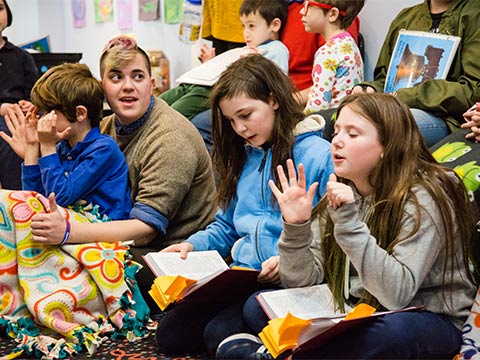
Makom Community is in an exciting place with regard to Tefilah (prayerful conversations) right now. With our new space and growing groups of both older Erev and younger Boker students, we have all kinds of thrilling, new opportunities to expand our model for teaching Tefilah. Our younger students engage with Tefilah in a few ways:
1) Communal Singing
2) Movement that lends meaning to the words of the liturgy
3) Contextual conversations that support them in applying the meaning of the liturgy to their lives
Naturally, we want to take these even farther for our older students (mostly 3rd-5th Grade). That means having an eye toward teaching them Tefilah with these goals:
1) Being able to meaningfully participate in Jewish prayer in a variety of communities
2) Continuing to develop their skills to closely read and challenge the ideas and theology of a text
3) Learning the musical modalities of Tefilah and increasing skills for participating in and leading communal singing
4) Given their increased ability to understand abstract theological ideas, push them to create intertextual understanding of Jewish liturgy and add their own commentary for increased understanding
5) Navigating a siddur (prayer book) and feeling ownership of the book itself and its contents
6) Beginning the process of preparation for BMitzvah as a shaliach tzibur (prayer leader)
So how do we do that with our older learners?
1) We daven (pray) together! Every afternoon at Makom Community we all do an increasing amount of davening together, as we learn new tefilot.
2) Each learner has their own siddur. As a matter of the accessibility we demand of Jewish participation at Makom Community, we are using this siddur. It invites deep research, deep questions, and making theological choices to inform how we say many prayers. It’s also fully transliterated (Hebrew written out in English letters) so all of our parents will be able to participate with it fully as we use it in the years to come.
3) Transliteration for our Makom Community learners? Nope! We take colorful post-it notes and cover the transliteration. Then our learners can add their unique questions, pictures, and commentary on top of the post-it notes to represent their learning journey through the siddur. This also ensures that they practice their Ivrit skills by reading the words to the tefilot in Hebrew.
4) Collective learning with rewards! As every learner in our group masters a Tefilah (see #5 below), they get to choose together from a list of rewards they created to revel in and share their accomplishment.
5) Learning for mastery! For each prayer, our learners complete three parts of the process:
a) Be able to read every word of the Hebrew independently. If our learners are reading fluently, they will be more able to jump in and sing along, even with an unfamiliar melody.
b) Be able to start a melody so that others can join us. We are building the skills to be a shaliach tzibur and lead a community in prayer.
c) Have a conversation with Beverly or another teacher that includes asking three great questions about the text of the prayer, summarizing the meaning, and making any necessary decisions about theological variants offered by our siddur. This is the richest and most exciting piece of mastering a Tefilah. These are the conversations that make clear that Jewish practice is not pediatric or for the faint-of-heart. We’re asking big, serious questions and grappling with them together. See below for some snippets of these conversations and the way we grapple.
Questions About God:
- If somebody loves us, why would we fear them?
- If we fear someone, why would we have a close relationship with them?
- Is it really God making all these daily things happen? What is it that we’re doing?
- Oh! We’re praising God for things we do every day.
- If we praise God, maybe they will praise us back!
- These were our ancestors, aren’t we like them? We want to be remembered like they were so God will help us.
A Snapshot Conversation about Tefilah:
Beverly: Let’s Daven!
3rd grader: Yay!
Beverly: That made my day!
3rd Grader: It’s my favorite thing we do here. It’s when everyone is together.
Thoughts about Redeemer or Redemption as Models for a Better World
- A redeemer would need superpowers
- A redeemer might even need to be God, Godself!
- Redemption…
- More achievable
- A group of people can get done more than just one person
- We can hold each other up
- We can help each other
- We can pick each other back up
- One person isn’t enough, even if they’re SUPER.
- The world can’t be fully redeemed anyway. It’s too broken.
- Some people carry too much hurt to be happy, so they stay sad and want other people to stay sad.
- Redemption could be amazing, even if it only lasts for a moment and isn’t a permanent status.
- No wars!
- Even a little “I hate you” could ruin redemption.
